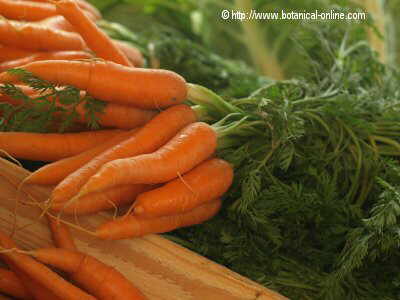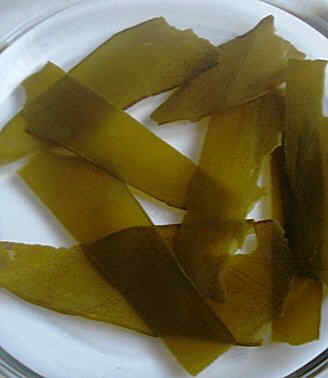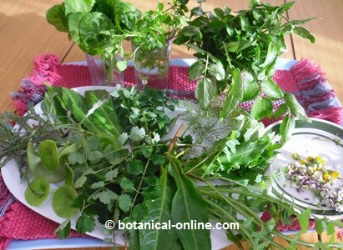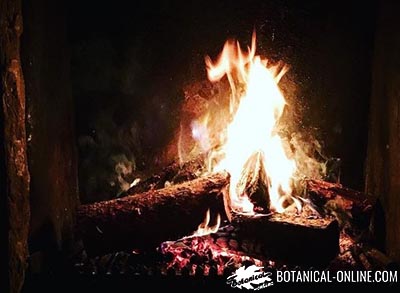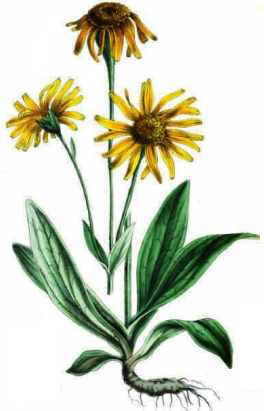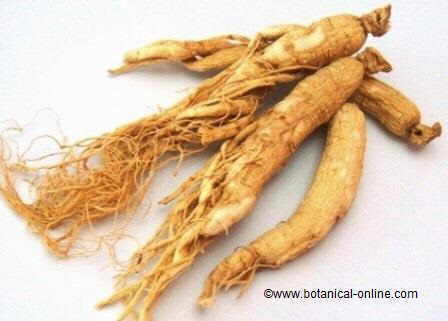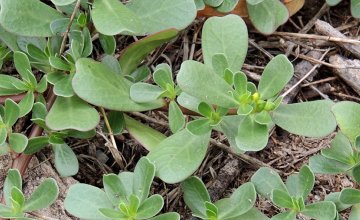Contents
- 1 Characteristics of plants and trees of Quercus gender
- 1.1 Characteristics of oak trees and other quercus
- 1.2 What is a Quercus?
- 1.3 How are Quercus like?
- 1.4 Types of oak
- 1.5 Uses of oaks
- 1.6 Oaks are good wood trees
- 1.7 Oak for the production of wine barrels
- 1.8 Other Quercus trees uses
- 1.9 Oaks are trees with medicinal properties
- 1.10 Oaks are trees with edible fruits
- 1.11 Edible uses of acorns
- 1.12 How can you eat acorns?
- 1.13 What are oak galls?
- 1.14 Types of galls
- 1.15 Oaks are trees with properties for chemical industry
Characteristics of plants and trees of Quercus gender
Characteristics of oak trees and other quercus
What is a Quercus?
Quercus genus (oaks, holm oaks, white oaks, etc.) comprises about 600 species of plants. Most of them are trees that live in temperate regions. There are also species in tropical and subtropical areas of Mexico and Southeast Asia.
How are Quercus like?
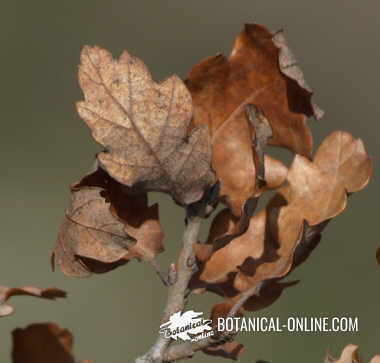
Oak leaves in winter. Some oaks such as the downy or pubescent oak (Quercus pubescens) are considered to be marcescent, because they keep the dry leaves on the tree during the winter until the new leaves are born in spring.
Some of them are bushes with little more than one meter in height; other are trees reaching over 40 meters. They can be evergreen or deciduous. Most of them produce lobed lobed and leathery leaves although there are some with much more tender leaves.
Because of the density of its foliage, oaks are considered good shade trees, from which not only human but a very large amount of forest animals take advantage.
Oaks produce male flowers in yellowish green shaped catkins. The female flowers are very showy.
The fruits of oaks are nuts, that are commonly known as acorns.
Types of oak
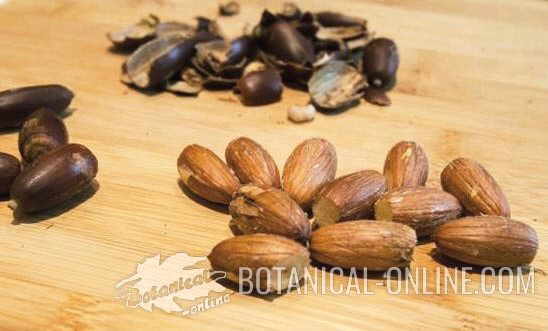
Photo of acorns.
The types of oak acorns divide into two groups:
- Oaks with sweet acorns: Those that produce acorns less tannin content. These mature in one year and are edible.
- Oaks with bitter acorns: Those that produce more tannin content in the acorns. These mature in a couple of years and are not edible and can cause poisoning in case of large intakes, although its unpleasant taste does not encourage ingestion.
Uses of oaks
Oaks are good wood trees
Oaks are trees that produce good wood, very tough, elastic and designed to withstand moisture. For example, oak wood has traditionally been used to make furniture, for building houses or for railway sleepers.
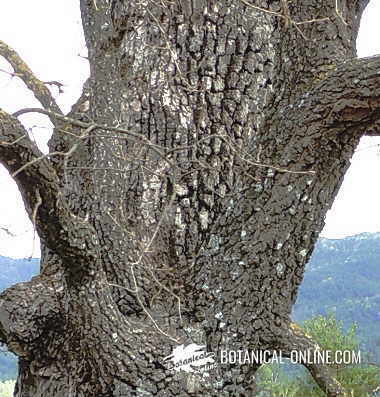
Detail of an oak trunk. The bark of this tree is used with medicinal properties.
Ancient oak trees were very abundant in temperate regions in Europe. From the time of the Greeks these were used to make boats. This use lasted until the early twentieth century. Overexploitation, especially that produced for shipbuilding during the colonization of the New World, led to the felling of many species, that drastically decreased the area of woodland. Even today wooden boats are made of oak planks.
We must not forget that cork is extracted from a member of this genus, called cork oak (Quercus suber). Cork is developed by this tree in order to protect the plant against fire.
Oak for the production of wine barrels
In enology, oak wood is considered the best for the maturation of wines and spirits. Casks that house wine, whiskey, cognac or sherry should be made with oak.
Also, this wood has traditionally served for making tools to work the land. Plows, bars, grilles, wheels, rollers, hoe handles and other farm implements were manufactured from wood from any of these trees, testing its strength and toughness many times.
Other Quercus trees uses
The wood of many of these trees, such as holm oak tree (Quercus ilex) was used in the past for the production of charcoal. A similar species, Quercus ilex rotundifolia, forms and impenetrable thorny landscape in some Mediterranean areas. In the past, it was used as fuel for the furnaces that manufactured bread or other industrial furnaces dedicated to ceramics.
Oaks are trees with medicinal properties
In addition to its use as wood, leaves and bark of oak, and not so frequently fruits and oak apples (galls), have been used and are used in herbal medicine. Oak medicinal properties derived from its astringent properties that are granted by its richness in tannins (gallic and ellagic acid) and catechins. (More information on its medicinal properties)
Oaks are trees with edible fruits
Sweet acorns are good food for many wild animals such as mice, squirrels, wild boars. Very large areas of this tree are found in the Iberian Peninsula designed to produce acorns for the famous Iberian pigs. Precious hams are obtained from them.
Edible uses of acorns
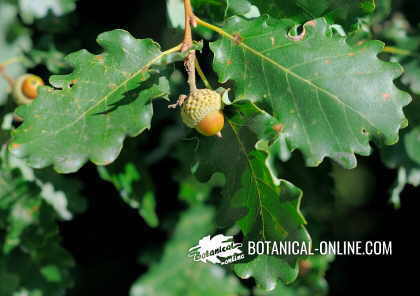
Detail of an oak fruit (acorn) and leaves
Sweet oak acorns have been the staple food of the first hunter-gatherer people of both Europe and America. In the first continent, acorns of oak (Quercus ilex) and, in the second one, those of the white oak (Quercus alba) were collected by the first settlers to eat them raw or toast them as if they were chestnuts.
Subsequently, these people learned to prepare acorn flour, after removing tannins by means of boiling them many times and removing the boiling water. With this flour, they could produce bread or could make soups by mixing with other wild herbs. Even substitute of coffee drinks have been made.
How can you eat acorns?
One technique used by American Indians to make them edible was to mix the acorn pulp with clay in a proportion of 1 part clay with 20 acorn. This managed to neutralize tannins, shaping the roughness of these fruits and make them edible. It appears that this combination also acted as a yeast that increased the volume of the mass. Currently, an acorn de-matting technique is used.
What are oak galls?
Galls produced by these trees are very curious. These are excrescences produced by these plants so that different parasites can live in them without damaging the wood of these trees. It is estimated that an oak can be colonized by more than 500 species of insects.
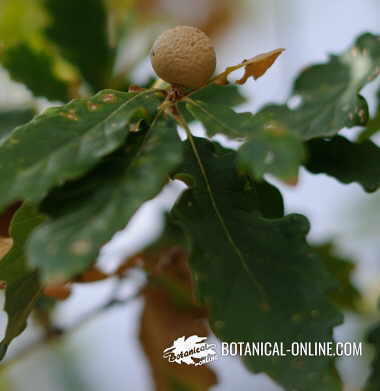
Detail of a gill on an oak twig
Types of galls
It deserves mention some examples like the galls produced in very dry climates of the southwestern United States, northern Mexico and Australia by honey ants (Myrmecocystus).
These ants gather the nectar produced in these galls and take it to their nests where a specialized group of ants saves into their vast abdomens to serve ad food for the other ants. Many Indians and native Australians prefer this type of honey to that produced by bees so they dig nests in search of these precious ants.
Oaks are trees with properties for chemical industry
Oak bark substances have been used in industry for the manufacture of dyes. Also its high tannin content has been used for the tanning industry. From oak galls can be obtained a dye that is mixed with other elements to achieve different shades. For example, from the kermes oak (Quercus coccifera L.) the ink called Grana Kermes is obtained.
Black ink is obtained mixing the liquid from oaks with iron salts. The decoction of oak bark, combined with a little iron sulfate, produces a very resistant to washing purple dye.
![]() More information on oak.
More information on oak.

